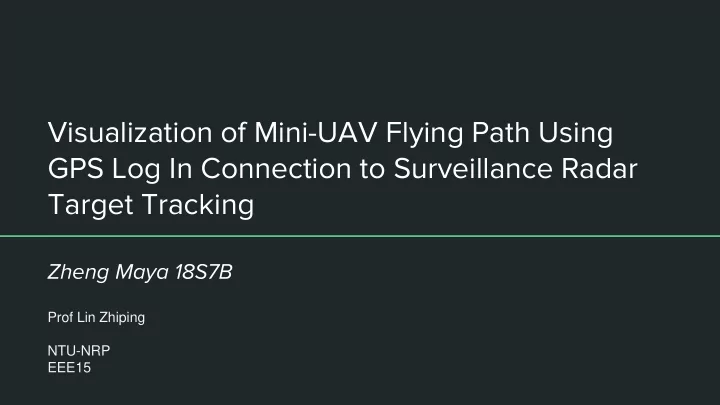

Visualization of Mini-UAV Flying Path Using GPS Log In Connection to Surveillance Radar Target Tracking Zheng Maya 18S7B Prof Lin Zhiping NTU-NRP EEE15
Radar Tracking Image taken from: https://www.eol.ucar.edu/content/how-do-radars-work ❖ What is Radar: ➢ RAdio Detection And Ranging ➢ Object-detection system ➢ Produce radio or microwaves which are Reflected off objects to receiver
UAV (Unmanned Aerial Vehicles) ❖ What is a UAV/Drone ➢ Flying Aircrafts controlled without a pilot within the aircraft ➢ May have built in sensors and GPS for easy tracking and control ❖ Types: Micro/Nano-UAV Mini-UAV Medium-UAVs Large-UAVs
Small size Low flying altitude Slow flying speed Weak Echo Signal Mini-sized Unmanned Aerial Vehicles (mini-UAVs) Difficult targets to be detected by the current surveillance radar system
Research Aim ➢ Visualize the flying path of mini-UAVs based on GPS log ➢ Investigate into Radar target tracking errors by means of a comparison between the GPS flying path and the radar tracking results
RESEARCH DATA ❖ Type of data used ➢ GPS ➢ Radar ❖ How was data obtained? ➢ Flight trials ➢ Radar: SQUIRE Radar log
Methodology: Visualize the flying path of mini-UAV ❖ Extract Longitude , Latitude , Relative height , and Acceleration from GPS data ❖ Use MatLab ➢ Construct flying path from the extracted data ➢ Display the flight path in a 3D plot ➢ Determine Velocity of UAV at every point and alter the thickness of the trajectory to better visualize the movement of the UAV ❖ Draw a triangle to represent the UAV ➢ It moves along the trajectory to show the motion of UAV
Methodology: Visualize the flying path of mini-UAV (cont) ❖ Design a more effective GUI (Graphical User Interface) ➢ GPS data is converted into KML file, which is then presented in GoogleEarth ➢ An image of the flight path presented on GoogleEarth is screenshotted ➢ Image of the flight path is displayed in GUI
Methodology: Investigate Radar target tracking errors ❖ Convert GPS coordinates to Polar Coordinates ❖ Interpolate ➢ Alter GPS time frame and data coordinates to match those of the radar time frame ❖ Eliminate time lag ➢ Radar data lags behind the GPS data time ➢ Eliminate time lag after interpolation
Methodology: Calculation of Time Lag of Radar Tracking Calculate the Convert Visually Find part of Plot the Radar estimate time lag by GPS data that trajectory coordinates part of GPS using the time obtained has minimum into graph that that corresponds from radar difference with Cartesian matches to the point with data radar data min. error coordinates Radar graph
Results of Visualisation ❖ Successful visualization of trajectory with both 2D map and 3D maps
Results: Analysis of Radar Tracking Error (a) 3D trajectory from GPS data (b) 2D trajectory from Radar data
Results: Analysis of Radar Tracking Error (cont) (c) 2D projection of the full GPS trajectory (d) Estimated region that matches radar data
Results: Finding Minimum Error and Time Lag ❖ From the flying time, visualization of GPS trajectory and 2D Radar graph, the part of the GPS graph that appears to match the Radar trajectory shape is around points 550~1105 ❖ The difference between the range from radar data and that from GPS data was found and plotted into a graph. ➔ Our experiment with the three sets of data gives the time lag of 27, 26 and 33 seconds.
Discussion ● Developed methods for reconstructing the flying trajectory and speed of mini-UAVs from GPS data ○ and Radar data tools for visualizing the trajectory and animating the flying of the mini-UAV ○ approximate method for comparing the GPS and Radar trajectories and finding the errors ○
Conclusion ● The experiments show that the comparison of the data sets from GPS and radar can help find certain errors in the radar tracking, which can be used to analyze radar tracking errors and the pattern.
Thank You!!
Recommend
More recommend